Fig. 387 The Tos modified intact canal wall technique. Initial endaural incision. A medial circumferential incision extending from the 3-o’clock to the 5-o’clock positions and a radial incision at the 12-o’clockand at the 5-o’clock positions
The skin–subcutis is held in place with a self-retaining retractor, and the elevation of skin from the posterior half of the car canal proceeds as far as the previously performed circumferential incision, approximately 6 mm lateral to the annulus. The advantage of the previously performed circumferential and radial incision is now evident, and the laterally-based posterior ear canal skin flap can easily be elevated, pushed anteriorly, and held in place using a House–Sheehy, protecting, selfretaining retractor (Fig. 388). The meatal skin is carefully elevated from the superior bony wall, including the tympanosquamous suture, which is entirely exposed. The ear canal skin, anteriorly as far as the 2-o’clock position and inferiorly as far as the 5-o’clock position, is also elevated (Fig. 389). The extent of the elevation of the ear canal skin depends on the cholesteatoma type. In attic cholesteatoma with pathology particularly in the anterior attic, the elevation of the skin must extend far anteriorly, but to a lesser extent inferiorly, in the ear canal. In sinus cholesteatoma or tensa retraction cholesteatoma the elevation of the skin has to be extensive inferiorly in the ear canal.
The posterior tympanomeatal flap along with the fibrous annulus is elevated, and a large posterior tympanotomy is performed, exposing the posterior part of the tympanic cavity as well as the ossicular chain (Fig. 389).
Removal of Attic Cholesteatoma
After elevating the posterior malleolar ligament, and after following the chorda tympani toward the neck of the malleus, a small curved rougine is placed between the neck of the malleus and the neck of the cholesteatoma membrane as a search is made for a dissection plane in order to create a small malleus flap (Fig. 390). The cholesteatoma membrane from the neck of the malleus is now elevated, creating the small malleus flap (Fig. 391), and the ear canal skin anterior to Shrapnell’s membrane is also elevated. The malleus flap is thus created from the elevated retracted membrane from the malleus neck. It is attached to the short process of the malleus.
Otosclerosis Drilling
With a small diamond burr, so-called otosclerosis drilling is then performed, i. e., removal of the posterosuperior bony annulus, exposing the entire tympanic sinus and the stapes (Fig. 391). Any pathology, especially within the sinus typmpani, is carefully dissected, particularly the original cholesteatoma coming from the attic. The purpose of the otosclerosis drilling is, at an early stage in the operation, to certify the condition of the ossicular chain and to dissect the cholesteatoma from the sinus tympani under optimal conditions. The author is convinced that surgery around the stapes and in the tympanic sinuses is more easily and safely performed with the same technique as that for stapedectomy surgery. In majority of cases using this method, pathology from the posterior tympanum and tympanic sinuses can be safely removed, and a posterior atticotympanotomy is unnecessary in this approach. Therefore, one of the essential differences in this modification is that a posterior atticotympanotomy is not performed (Fig. 391).
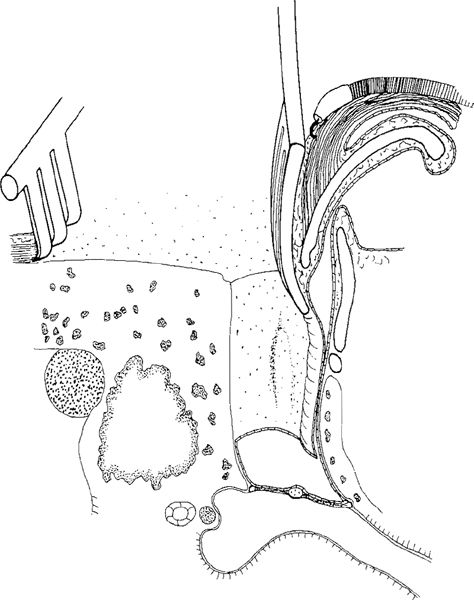
Fig. 388 Side view from same perspective of the retroauricular approach, with the posterior ear canal skin flap elevated, pushed anteriorly, and held in place with an House–Sheehy protective selfretaining retractor. At the superior wall, the tympanosquamous suture is indicated
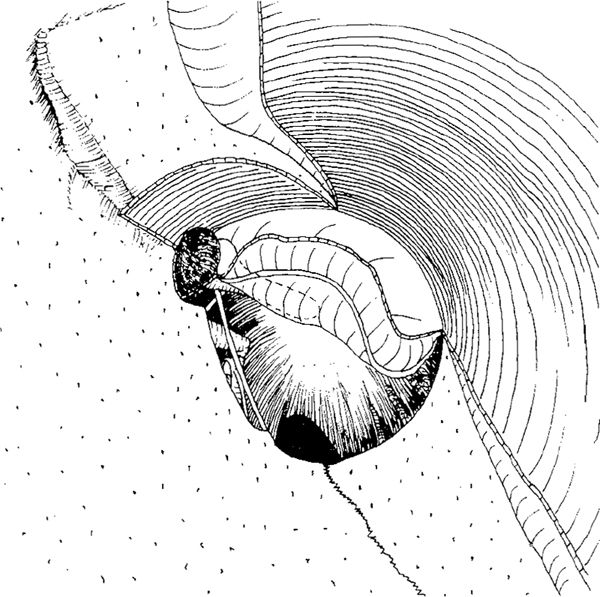
Fig. 389 View through the retroauricular approach into the tympanic cavity in a case of attic cholesteatoma with perforation, or retraction, in the Shrapnell’s membrane region, without major bone resorption of the frame. The canal skin is elevated anteriorly and inferiorly. The posterior canal skin flap is elevated and held in place on the anterior aspect of the ear canal, as shown in Fig. 388. A posterior tympanotomy is performed, and the tympanic cavity is inspected
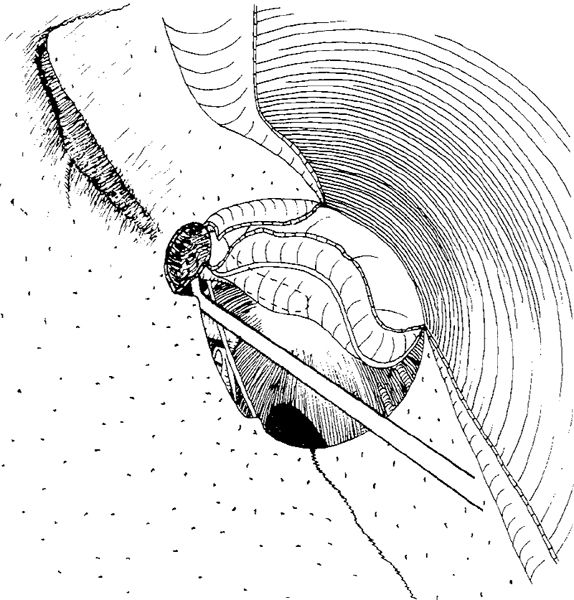
Fig. 390 With a curved elevator, a dissection plane is established between the neck of the malleus and the retraction of Shrapnell’s membrane, elevating the retraction in order to create a small malleus flap
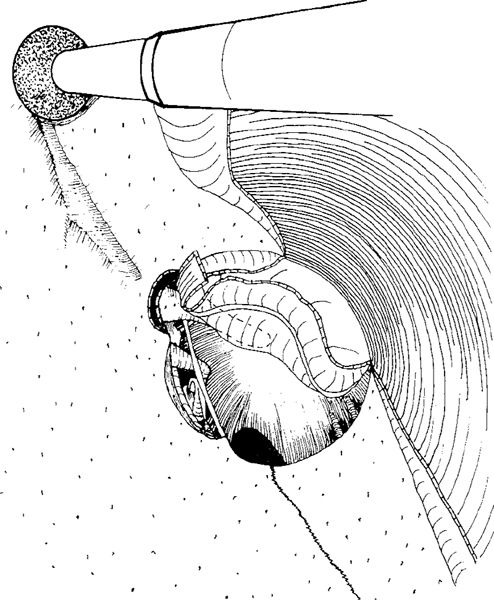
Fig. 391 Otosclerosis drilling. The malleus flap is elevated, with the base at the short process of the malleus. The malleus neck is cleaned of cholesteatoma, but the neck of the cholesteatoma sac extending into the attic is still in place and visible. Otosclerosis drilling of the posterosuperior bony annulus is performed, and the sinus tympani, the stapes region, and all the posterior tympanum is carefully inspected, with any cholesteatoma being safely removed from these regions. The drilling along the tympanosquamous suture is indicated
Transmeatal Atticotomy
Before performing a transmeatal atticotympanotomy, the irregularities of the superior bony wall, including the tympanosquamous suture, are drilled away using a large diamond burr. It is important to carefully dissect the skin, and sometimes the fibrous tissue between the skin and the tympanosquamous suture has to be cut with a pair of scissors or a knife (Fig. 391). By continuous drilling of the ear canal along the tympanosquamous suture, a small plateau is created at the level of the lateral attic wall, which facilitates the atticotomy (Fig. 392). With further drilling, the plateau at the lateral attic wall is enlarged, and the size of bridge to be preserved is carefully assessed. The ear canal is further drilled toward the anterior attic, enlarging and thinning the plateau, which is to be perforated (Fig. 393). Using a small diamond burr placed in the middle of the plateau, a hole is drilled through the bone, thus exposing the attic cholesteatoma as a whitish membrane (Fig. 394) — whereas, if there is no cholesteatoma, the bluish mucosa is clearly visible. The thinned bone of the lateral attic wall is gradually drilled away, exposing more and more of the cholesteatoma membrane (Fig. 395). The removal of the lateral attic wall is continued posteriorly (Fig. 396) and the entire attic is thus exposed. The bony bridge is thinned, but remains intact.
Early in the operation, the neck of the malleus has been cleaned, and the cholesteatoma membrane covering the neck of the malleus elevated (Figs. 390, 391). The cholesteatoma membrane is carefully elevated from the bony edges of the Shrapnell’s membrane region. The cholesteatoma within the tympanic cavity is removed, and the membrane is pushed under the bridge along the long process of the incus and into the attic.
Before debulking the cholesteatoma, the membrane is incised with a sickle knife (Fig. 397) and the cholesteatoma mass is evacuated, with a careful inspection being made of the condition of the ossicles (Fig. 398). Debulking of the cholesteatoma is an important procedure, allowing the extent of the cholesteatoma to be established including its pockets and protrusions into the anterior attic or towards the Eustachian tube. After removal of its innermost layer (Fig. 399), the outer matrix becomes visible, and can be elevated from the bone. The dissection of the outer matrix should be performed carefully under high magnification with gradual elevation of the entire matrix, exposing the incus body (Figs. 400, 401). The membrane and the underlying inflammatory tissue is elevated from the incus body in such a way that the incus mucosa remains more or less intact. If necessary, the atticotomy is enlarged along the short process of the incus (Fig. 402). The elevation of the cholesteatoma membrane continues toward the malleus head, with special care being taken to clean the inner surface of the bony bridge (Fig. 403). Further dissection of the cholesteatoma membrane follows its extension along the superior wall of the attic, preserving the superior incudal and malleolar ligament (Fig. 404). The cholesteatoma membrane is entirely elevated, especially from the anterior attic. The presence of cholesteatoma membrane under the bridge can be checked by moving a small curved instrument under the bridge and inspecting the elevated membrane (Figs. 405, 406). Finally, the last part of the cholesteatoma membrane is removed (Fig. 407), and the ossicular chain, which in many cases of small cholesteatoma will have remained intact, can be inspected.
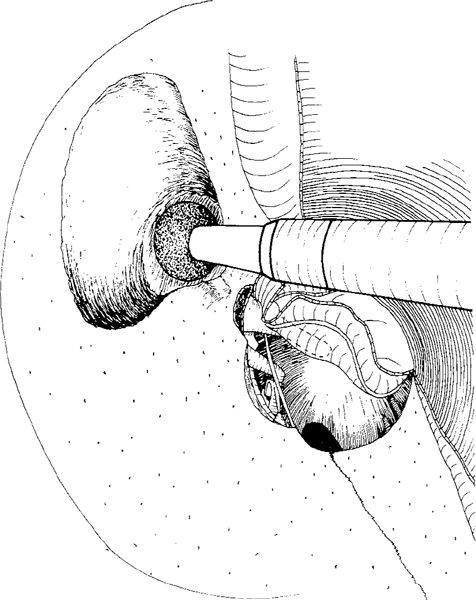
Fig. 392 Atticotomy. Drilling of the bone along the tympanosquamous suture is continued medially with a diamond drill, creating a plateau at the lateral attic wall region
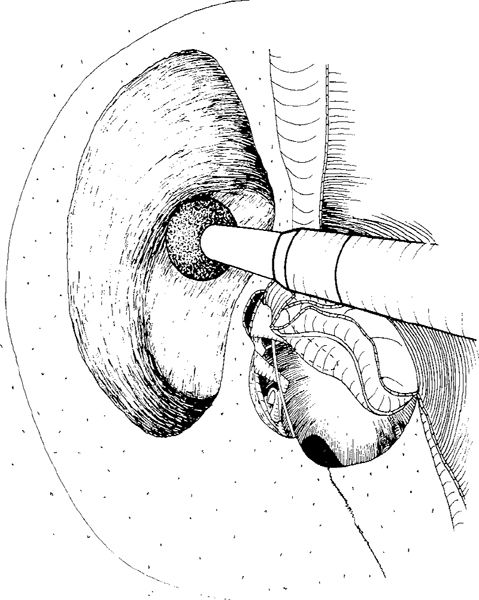
Fig. 393 The bony plateau lateral to the attic is enlarged, and the bony plate is thinned, with the bridge being kept intact
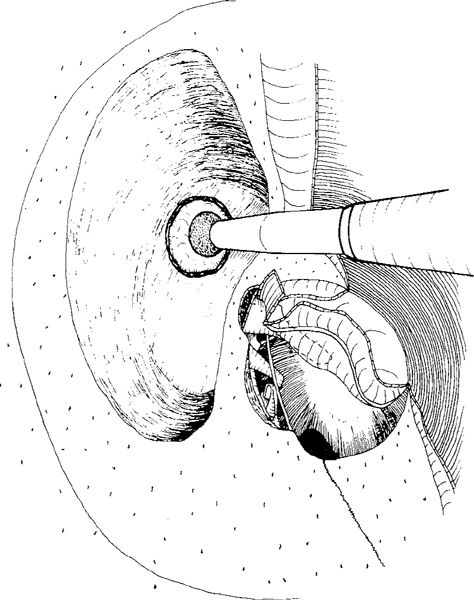
Fig. 394 The lateral attic wall is drilled away, and the attic is entered, exposing the cholesteatoma
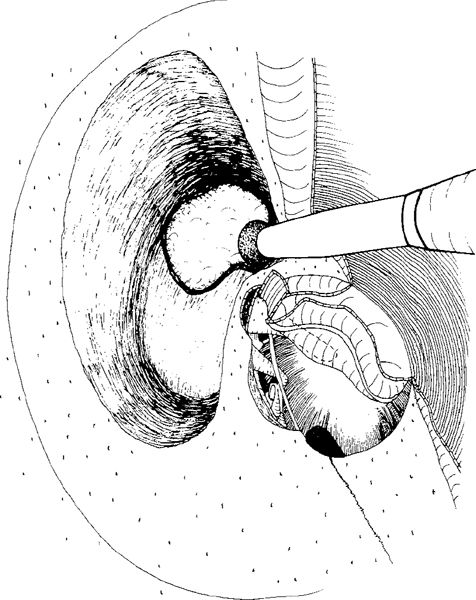
Fig. 395 Further removal of the lateral attic wall with a diamond burr

Fig. 396 The atticotomy has been completed. The bony bridge is preserved, and all the cholesteatoma in the attic has been exposed
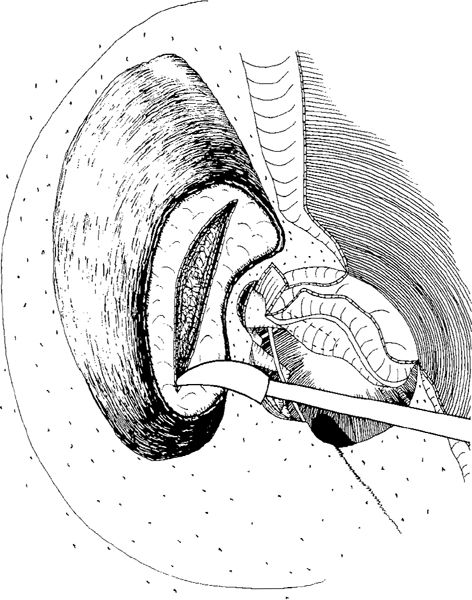
Fig. 397 Dissection of the attic cholesteatoma. The cholesteatoma sac is incised and will be debulked
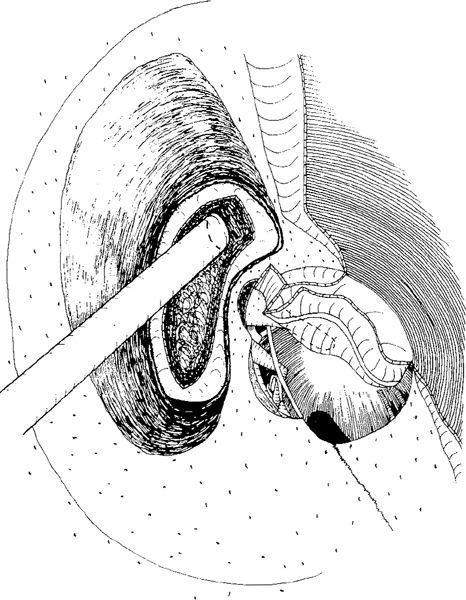
Fig. 398 Debulking the cholesteatoma mass with a suction tube and, if necessary, a rugine
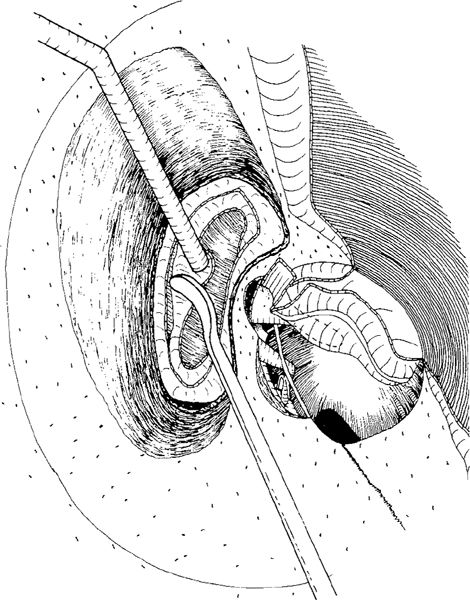
Fig. 399 Removal of one of the last cholesteatoma membranes. It is dissected away together with cholesteatoma mass from the cholesteatoma matrix
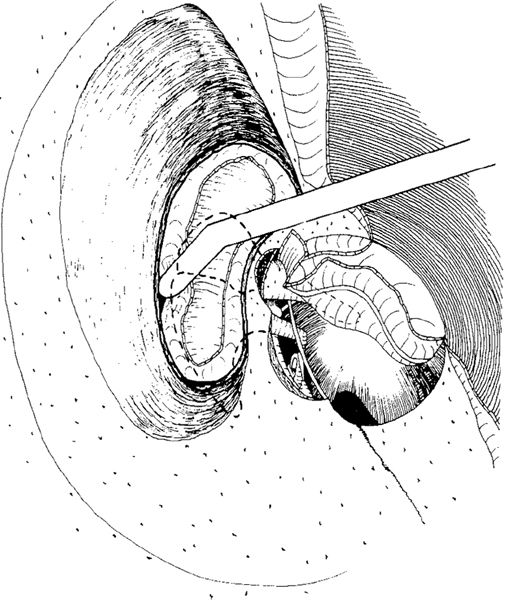
Fig. 400 The cholesteatoma matrix is attached to the ossicles and surrounding bone. It is gradually elevated from the bone
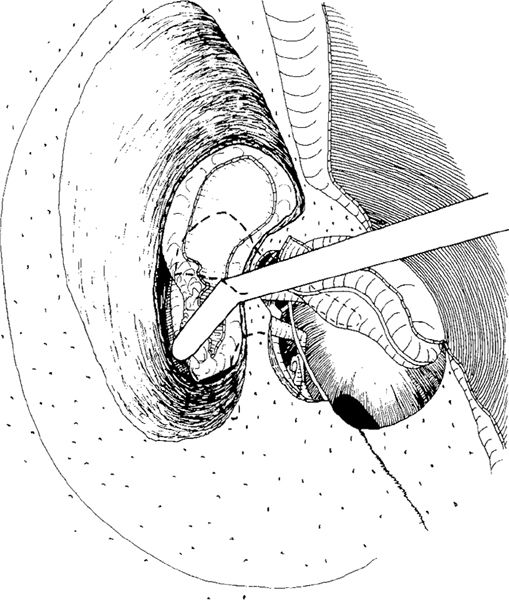
Fig. 401 The matrix is elevated from the inferior part of the attic and the incus body
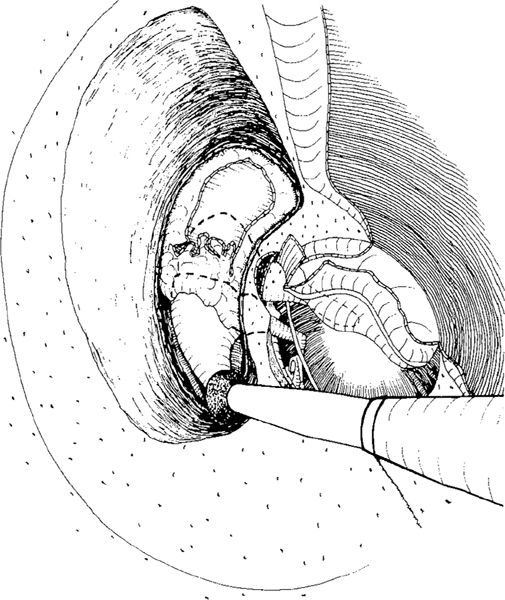
Fig. 402 The short process of the incus is exposed by enlarging the atticotomy opening toward the aditus
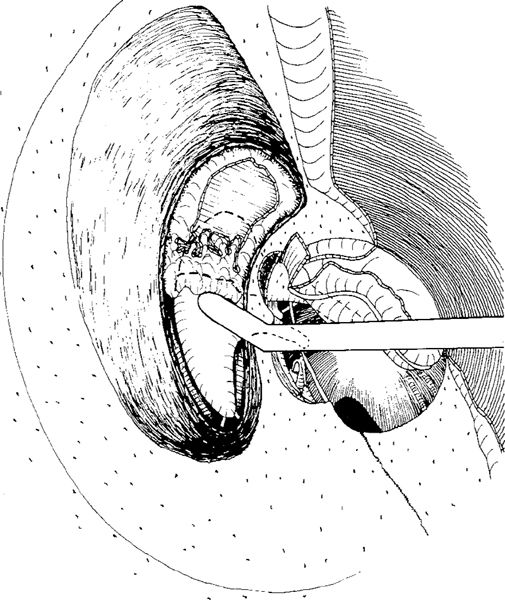
Fig. 403 Cleaning of the incus by elevating the cholesteatoma matrix
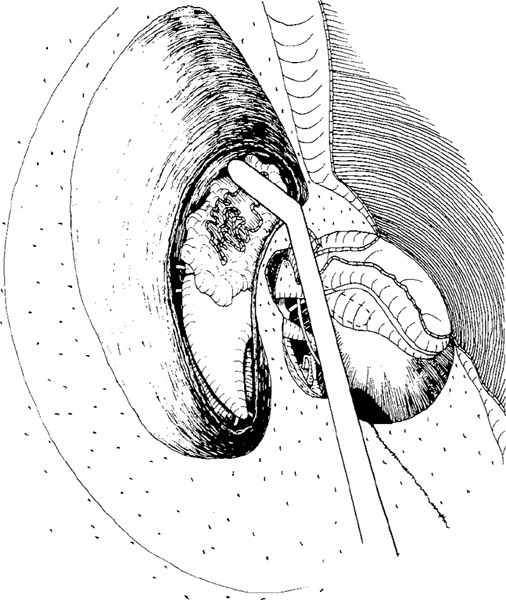
Fig. 404 Elevation of the matrix from the anterior attic
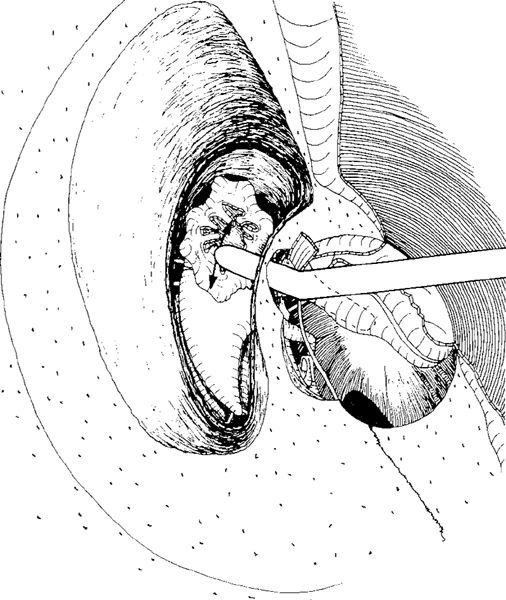
Fig. 405 The “external membrane” of the cholesteatoma neck attached to the undersurface of the bony bridge is elevated by moving a curved rugine in superior and inferior directions between the membrane and the undersurface of the bridge
Even if the cholesteatoma is totally removed, a cortical mastoidectomy is performed, partly in order to check the mastoid cavity for residual cholesteatoma, and partly to create a thin posterior bony ear canal wall. The reason for thinning of the posterior bony wall is that, if residual or recurrent cholesteatoma occurs in the attic, the thin bony ear canal will be gradually resorbed, and the opening to the attic will enlarge.
The mastoidectomy is performed, as described in Chapters 4 and 6, by thinning the posterior ear canal wall and exenterating as many cells as necessary. Because the aim of the operation is to repneumatize the mastoid cavity, the mucosa is widely preserved, and the mastoid cells are only exenterated in order to reach the antrum (Figs. 408, 409). After drilling of Körner’s septum and further thinning of the bony ear canal wall, the antrum is entered (Fig. 410). It is important to continue the thinning of the bony ear canal wall toward the anterior attic, and this is best performed using a diamond burr (Fig. 411). The thinning of the superior attic wall proceeds, and the position of the ossicles can be clearly inspected transmeatally, so that the drilling can be performed rapidly. Finally, the bony overhangs and the spicule of the anterior attic wall are drilled away (Fig. 412) and the ear canal wall becomes maximally thinned (Fig. 413). The idea of a combined approach in the author’s modification is to provide an opportunity to clean the ear canal wall from the atticotomy side and the mastoidectomy side (Fig. 414) and to clean the bridge from the atticotomy side and the tympanic cavity side (Fig. 405). By tilting the patient anteriorly, the lateral semicircular canal and the head of the malleus, as well as the incus body, are visualized, as in classic combined-approach tympanoplasty (Fig. 415), providing the opportunity to clean the ossicles from both sides.
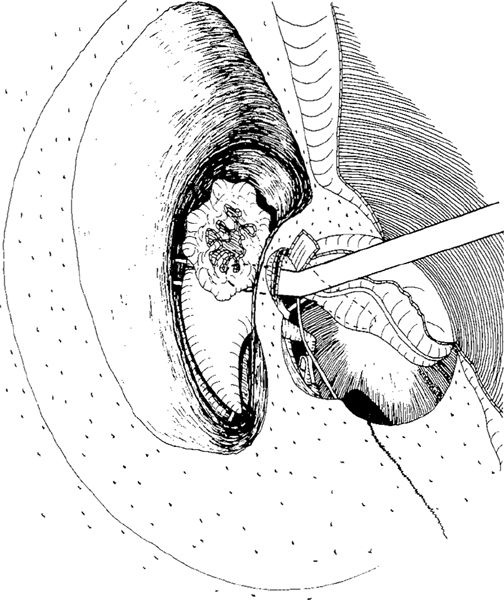
Fig. 406 Further elevation of the matrix from the malleus head. Using a curved rugine, the “internal membrane” of the cholesteatoma neck attached to the malleus head is elevated
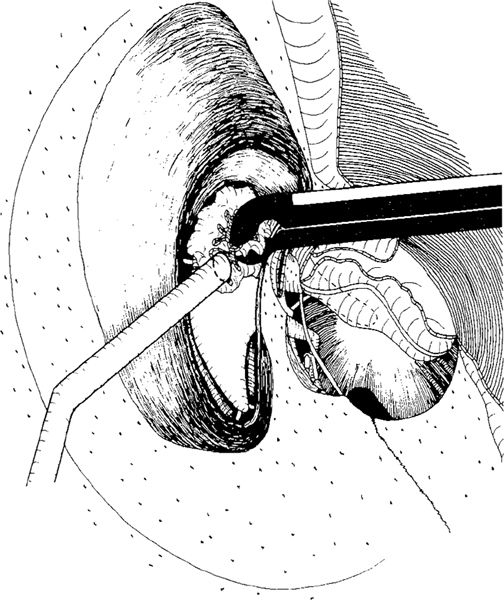
Fig. 407 Finally, all the cholesteatoma membrane is loosened from the ossicles, and this last part of the cholesteatoma matrix is removed as a bag
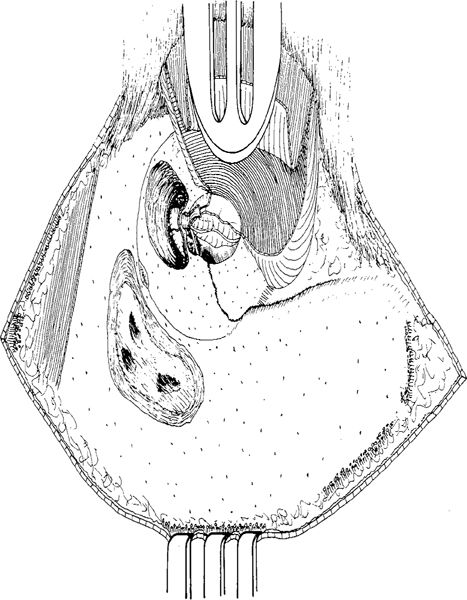
Fig. 408 Intact canal wall mastoidectomy. The drilling of the mastoid cortex starts behind the suprameatal spine
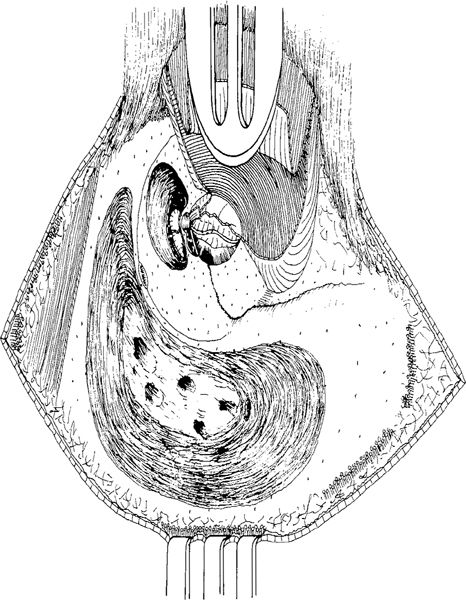
Fig. 409 The mastoid cortex is removed, and Körner’s septum is visualized
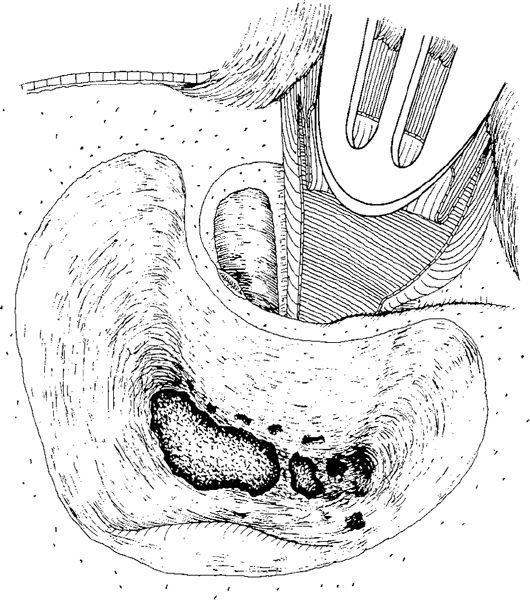
Fig. 410 Körner’s septum is penetrated and the antrum exposed. The ear canal is thinned
In cases with cholesteatoma in the antrum and the mastoid process, removal of the bone along the mastoid tegmen and enlargement of the anterior mastoidectomy is necessary (Fig. 416) in order to elevate the cholesteatoma membrane. However, it is still possible to clean the bony ear canal safely and accurately from both sides (Fig. 417).
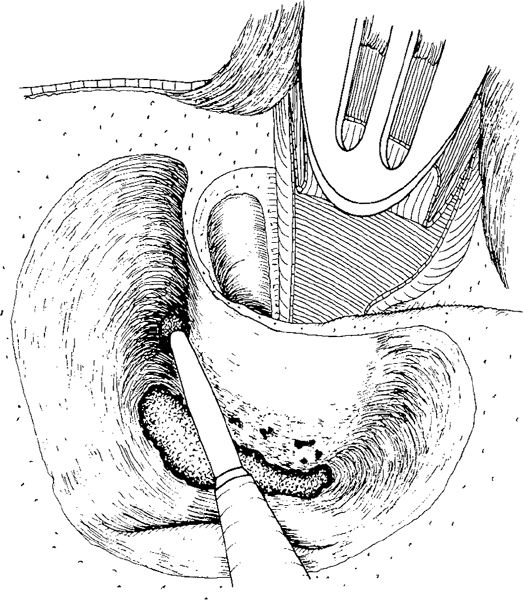
Fig. 411 The bone between the mastoid antrum and the ear canal is removed toward the zygomatic region
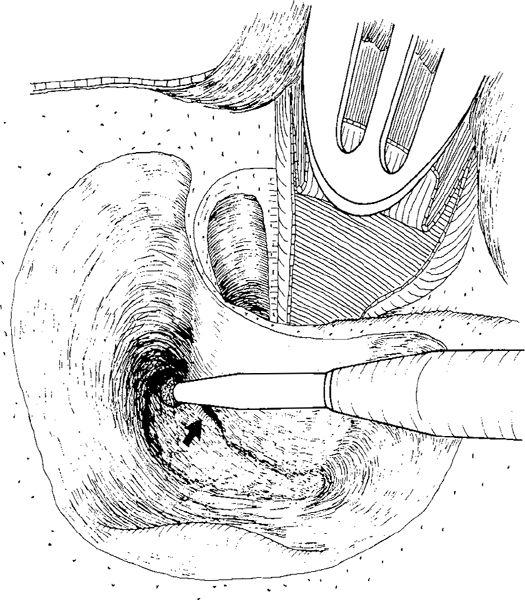
Fig. 412 Further drilling toward the zygomatic region, thinning of the posterior ear canal wall, and removal of the bony overhang covering the attic, allows exposure of the lateral semicircular canal (arrow)
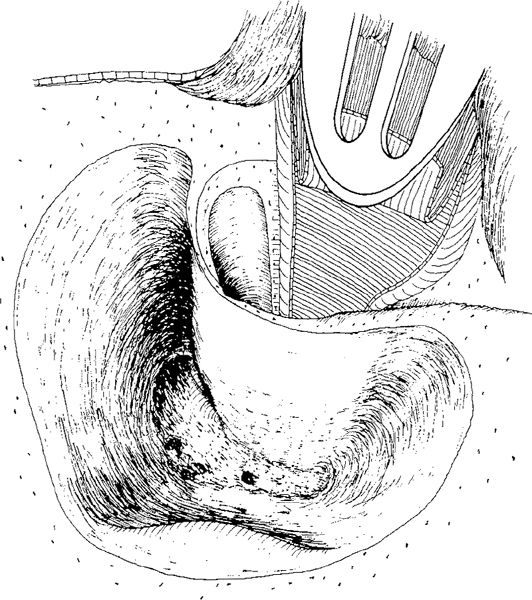
Fig. 413 The mastoidectomy is completed. The ear canal is thinned maximally, but the healthy mucosa is left in place
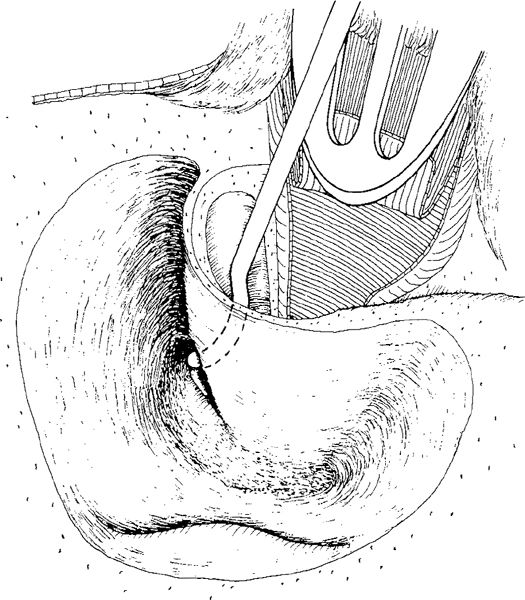
Fig. 414 Inspection and removal of any cholesteatoma remnant along the medial edge of the intact bony ear canal wall
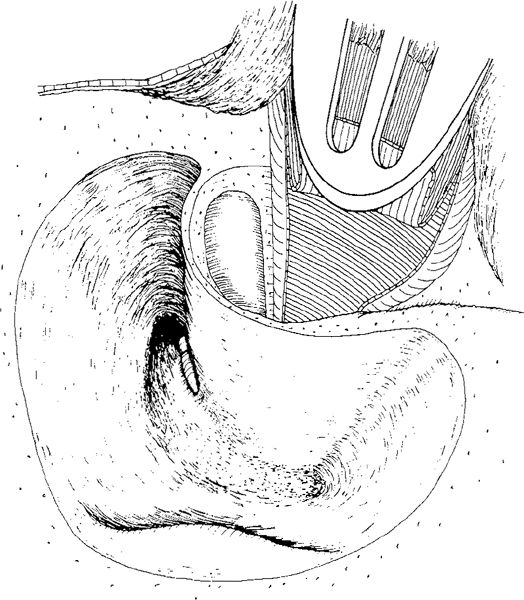
Fig. 415 When the patient is tilted anteriorly, the superior aspects of the ossicles become visible, and it can be ensured, that no cholesteatoma is left after it has been removed through the atticotomy
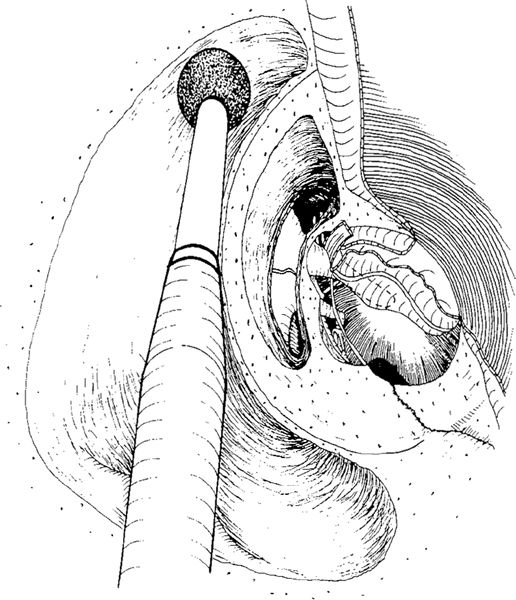
Fig. 416 Further drilling of the mastoid tegmen, enlarging the mastoid access to the anterior attic in order to perform transcortical (transmastoid) anterior atticotympanotomy
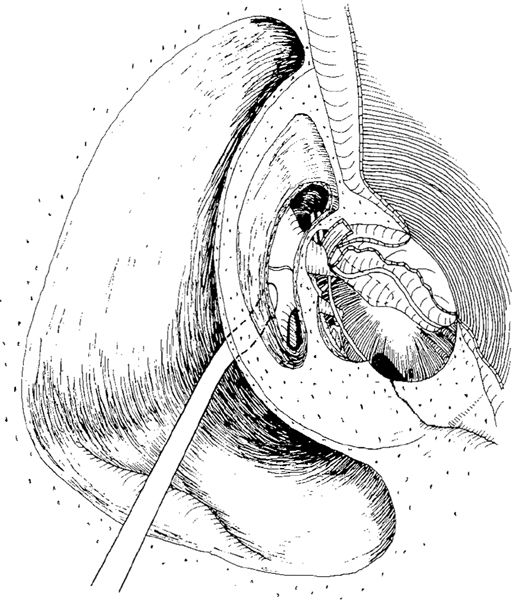
Fig. 417 The posterior edge of the intact bony ear canal wall is further inspected
Transcortical and Transmeatal Anterior Atticotympanotomy
Using this type of approach, a transcortical or transmastoid anterior atticotympanotomy can be performed in the same way as that described for classic intact canal wall mastoidectomy. By careful drilling of the bone along the tegmen tympani far anteriorly towards the anterior attic region (Fig. 418), and by removing the bony plate between the anterior attic and epitympanic sinus (the cog), the orifice of the Eustachian tube can eventually be reached.
The transmeatal anterior atticotympanotomy can most easily be performed by careful thinning of the anterior part of the bridge and transmeatal removal of the tensor tympani muscle fold (Fig. 419), with gradual drilling of the bone under the chorda tympani and the anterior malleolar fold (Fig. 420), until a good communication from the Eustachian tube to the anterior attic is established (Figs. 421, 422).
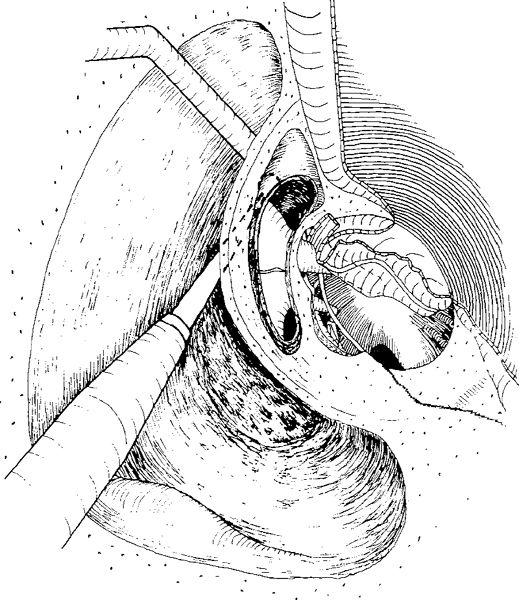
Fig. 418 Transcortical anterior atticotympanotomy. With a diamond burr placed through the mastoid cavity, the bony overhang covering the anterior attic is drilled away, enlarging the attic so as to be able to remove the bone separating the attic from the epitympanic sinus
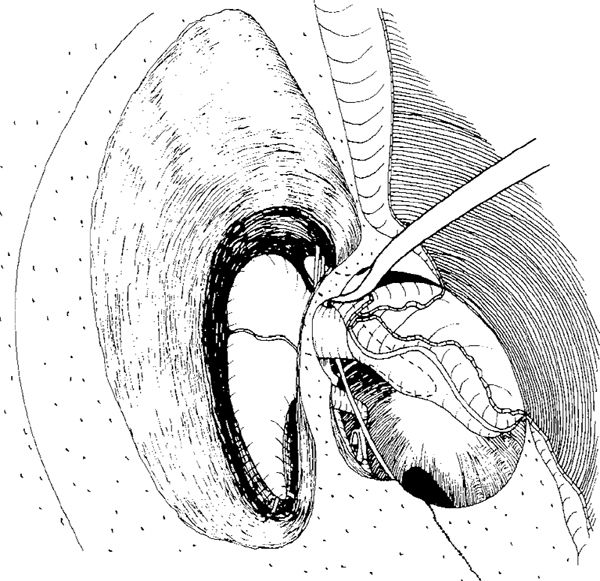
Fig. 419 Anterior tympanotomy. The fibrous annulus is elevated between the 12-o’clock and 3-o’clock positions, and the anterior tympanic cavity is inspected. With a curved rugine placed transtympanically into the anterior attic, the tensor tympani fold, if present is torn, and a passage between the anterior attic and the mesotympanum is established
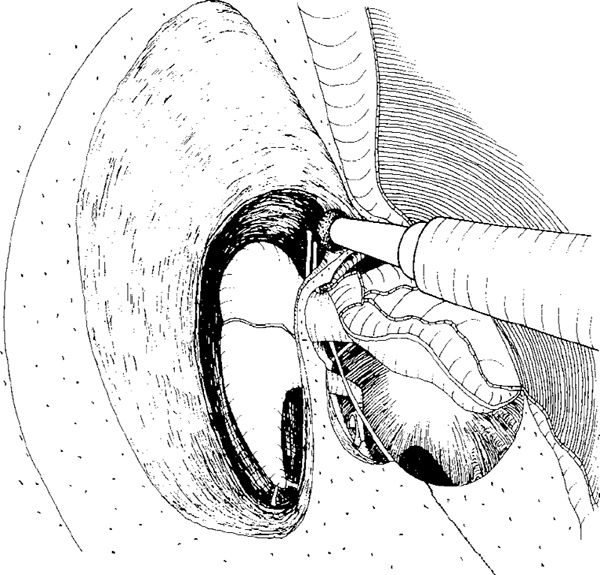
Fig. 420 Transmeatal anterior atticotympanotomy. Further drilling of the bone from the attic wall and thinning of the bridge, enlarging the access for the anterior atticotympanotomy
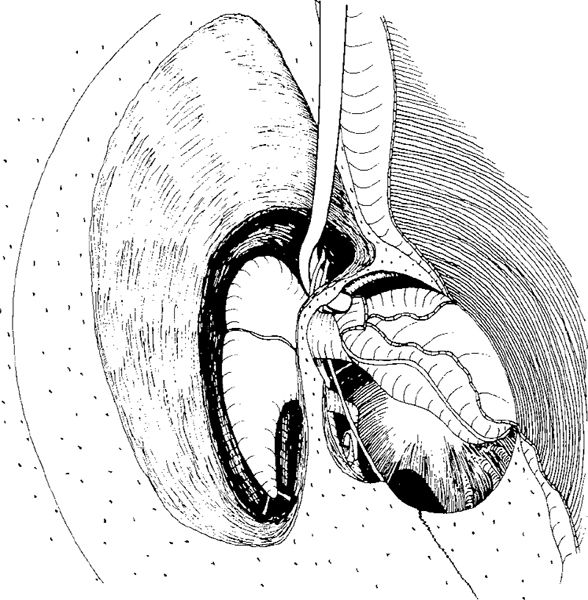
Fig. 421 A curved rugine is placed under the chorda tympani and the anterior mallear fold, and the connection to the tympanic cavity is further established
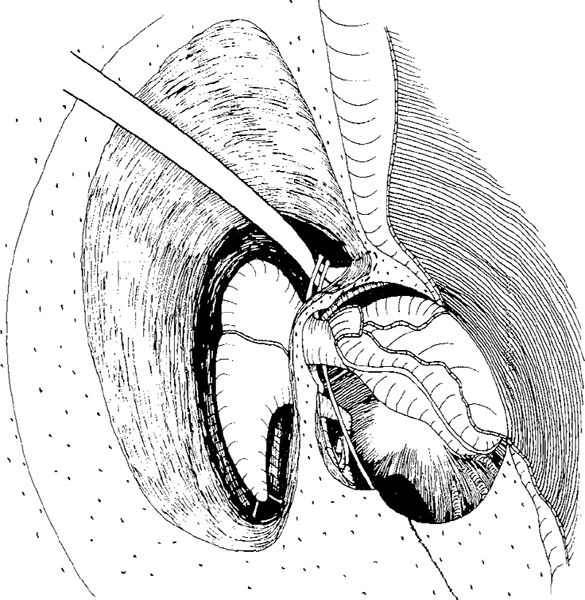
Fig. 422 The curved rugine is placed under the chorda tympani, through the epitympanic recess, and into the orifice of the Eustachian tube
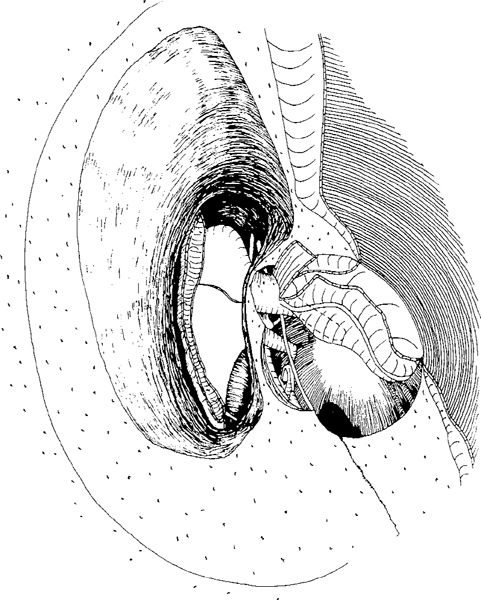
Fig. 423 Removal of large attic cholesteatoma. After otosclerosis drilling and atticotomy, the cholesteatoma from the anterior attic, the tympanic sinus, and the lateral attic is removed, preserving the ossicular chain intact. The cholesteatoma continuing into the antrum is left in place
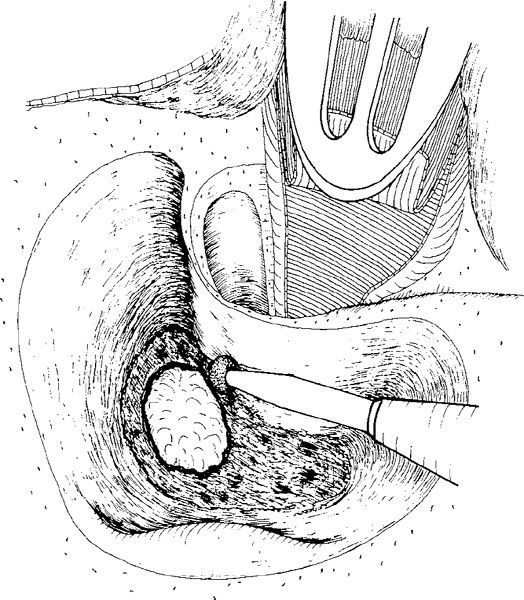
Fig. 424 Modified intact canal wall mastoidectomy. After the mastoid cells have been exenterated and Körner’s septum penetrated, the cholesteatoma is exposed, and further bone around the cholesteatoma is removed
Removal of Large Attic Cholesteatoma
If the cholesteatoma extends into the antrum, and the superior border of the cholesteatoma membrane cannot be removed through the atticotomy opening, then this part is left in place, and is dissected after the intact canal wall mastoidectomy (Fig. 423). After the mastoidectomy and thinning of the posterior ear canal wall have been carried out, and after the antrum has been exposed, the cholesteatoma becomes visible, and is removed using the same principles as described previously, i. e., gradual deroofing by drilling the bone away with a diamond burr and elevating the matrix from the bone (Fig. 424). After the roof of the cholesteatoma in the antrum has been removed, the plane between the bone and the cholesteatoma membrane can be established (Fig. 425), and the cholesteatoma sac can be elevated from all sides (Fig. 426). After incision of the matrix, the debulking of the cholesteatoma is performed using a large suction tube and a rougine (Figs. 427, 428). The debulked cholesteatoma can now be gradually dissected away from the bone. The cholesteatoma membrane is elevated from the lateral semicircular canal, with care being taken to note any underlying fistula. Elevation of the membrane from the lateral semicircular canal should be carried out in such a way that no sharp instruments are directed toward the semicircular canal, so as to avoid probing with an instrument into an unsuspected fistula (Fig. 429). After dissection of the cholesteatoma from the medial edge of the bony ear canal wall (Fig. 430), care should be taken to assess its extent medial to the incus body. Elevation of the membrane from the medial side of the incus can sometimes be carried out without any need for incus removal. The membrane has to be elevated gradually from all sides, first from the edge of the bony canal wall, then from the short process of the incus, in order to identify the proper cleavage plane (Fig. 431). To get better access to the anterior attic, more bone from the mastoid tegmen and tegmen tympani must be drilled away (Fig. 432). Access to the tympanic orifice of the Eustachian tube is widened by transmastoid atticotympanotomy, as described previously. Finally, the cholesteatoma membrane is elevated from the incus and malleus, maintaining them intact if possible (Fig. 433). Dissection between the ossicles and the medial wall of the preserved bony ear canal wall is carefully undertaken (Fig. 434) from all sides by gradually rolling the membrane under the bony ear canal toward the opening of the atticotomy (Fig. 435), where the last part of the membrane can be removed by suction or by using curved forceps (Fig. 436). After complete removal of the cholesteatoma, a final check for residual cholesteatoma is undertaken using a curved instrument, moving it along the inner edge of the posterior ear canal wall and the inner edge of the bridge (Fig. 437). In addition the connection between the anterior attic and the tympanum is established and secured by removal of the tensor tympani fold and any other adhesions located in the inferior attic and by further removal of the bone, allowing entry into the epitympanic sinus and the supratubal recess, as indicated in Figures 419–422.
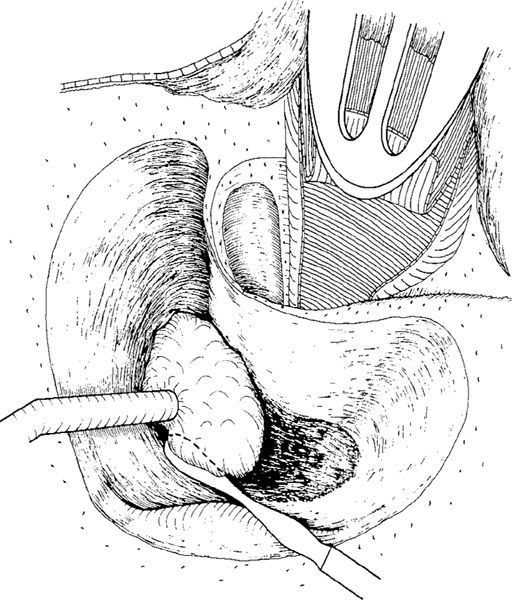
Fig. 425 The bone around the cholesteatoma is removed. The cholesteatoma sac is elevated from the bone
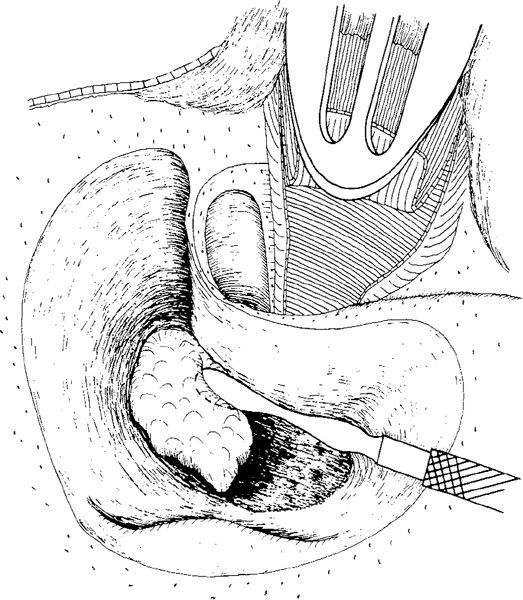
Fig. 426 Further elevation of the cholesteatoma sac anteriorly
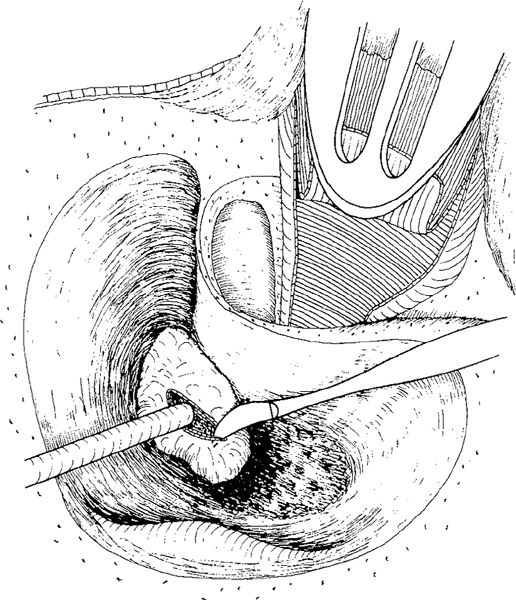
Fig. 427 The cholesteatoma sac is incised and debulked using a suction tube
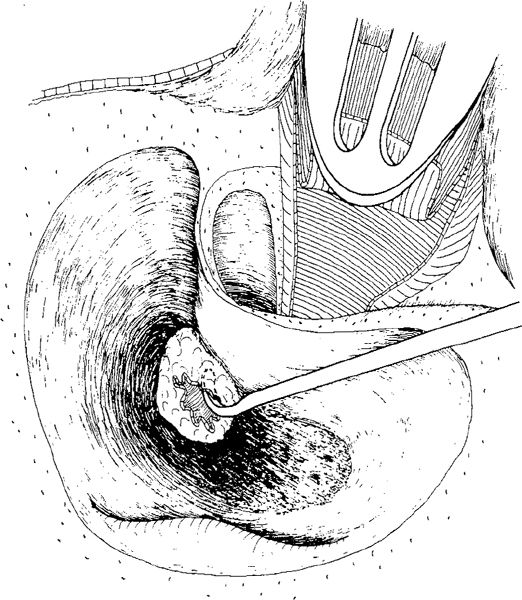
Fig. 428 The debulked cholesteatoma is elevated from the medial wall of the antrum, the prominence of the lateral semicircular canal is carefully palpated to exclude a labyrinthine fistula
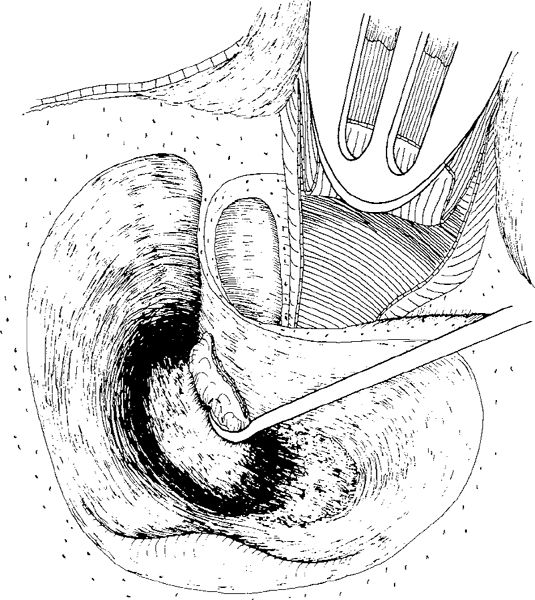
Fig. 429 The “medial” cholesteatoma membrane is elevated from the lateral aspect of the semicircular canal. With a curved rugine, the cholesteatoma membrane is dissected from the border of the ear canal
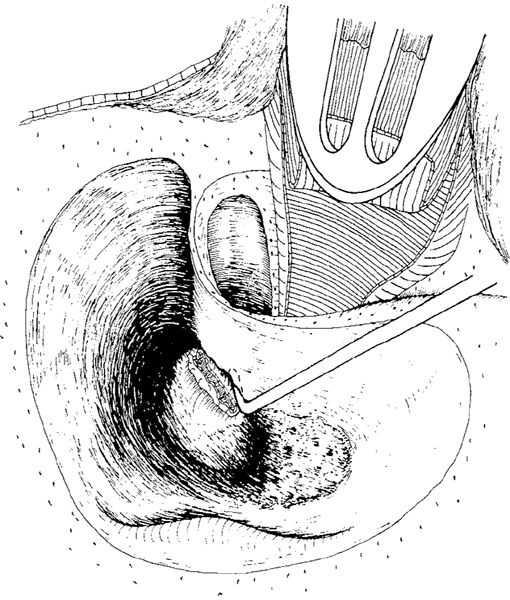
Fig. 430 A curved rugine is placed transmastoidally under the medial edge of the bony ear canal wall, and the “lateral” cholesteatoma membrane is elevated from it
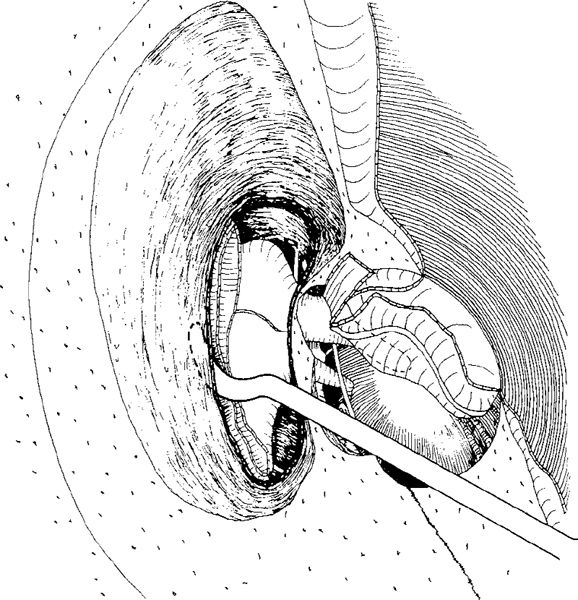
Fig. 431 A curved rugine is placed through the atticotomy, and the “lateral” cholesteatoma membrane is further elevated from the medial border of the intact bony ear canal wall
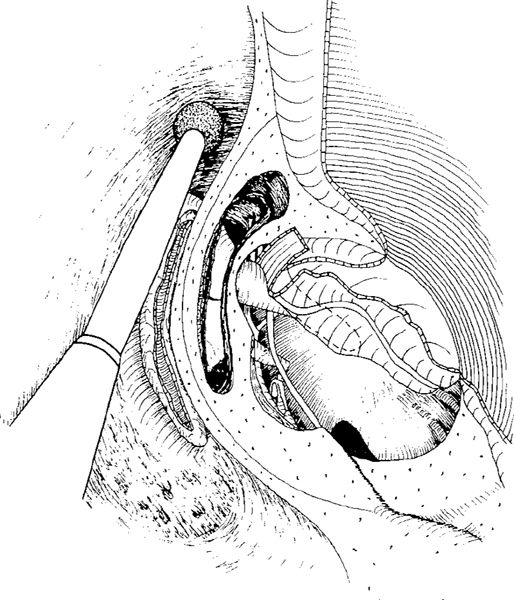
Fig. 432 To obtain acess to the anterior attic, more bone is drilled away from the mastoid tegmen
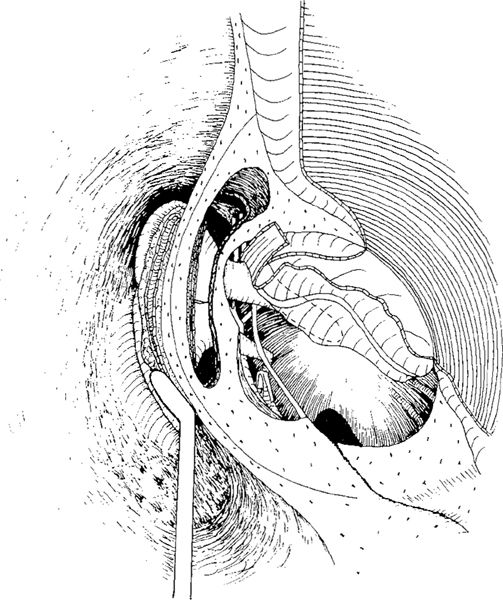
Fig. 433 The “medial” cholesteatoma membrane attached to the medial and superior aspects of the incus body is carefully elevated
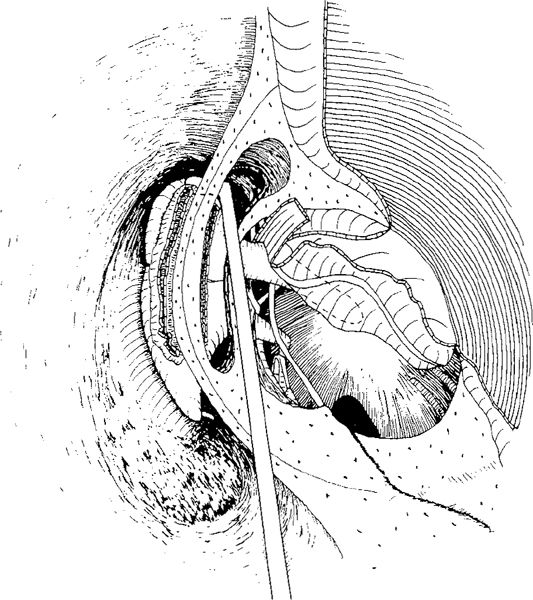
Fig. 434 The adherent cholesteatoma membrane is elevated from the lateral aspects of the incus body and malleus head
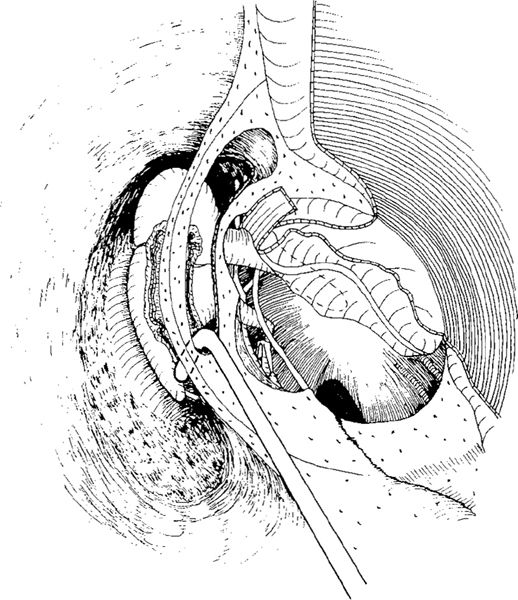
Fig. 435 The short process of the incus is cleaned of cholesteatoma membrane through the atticotomy, and is inspected through the transmastoidal route
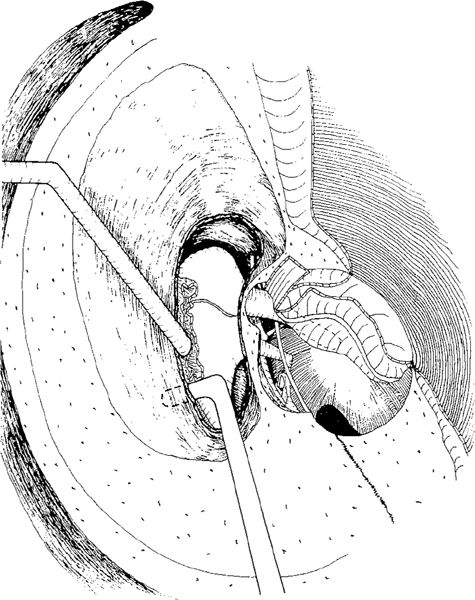
Fig. 436 Final removal of the completely elevated and freed cholesteatoma membrane by pushing it out of the attic with a curved rugine and pulling it with a strong suction tube
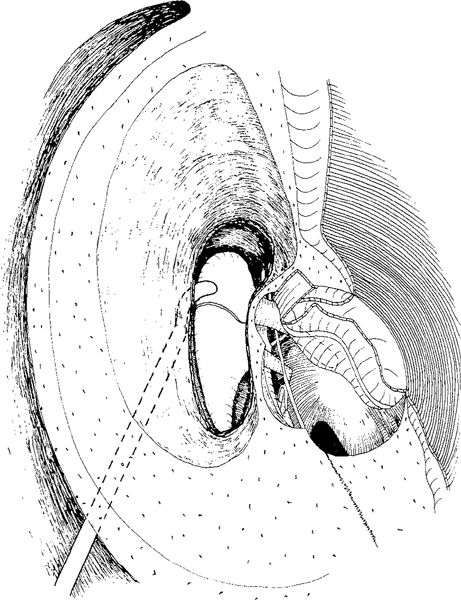
Fig. 437 Further checking and cleaning of the medial edge of the intact bony ear canal wall with a curved rugine
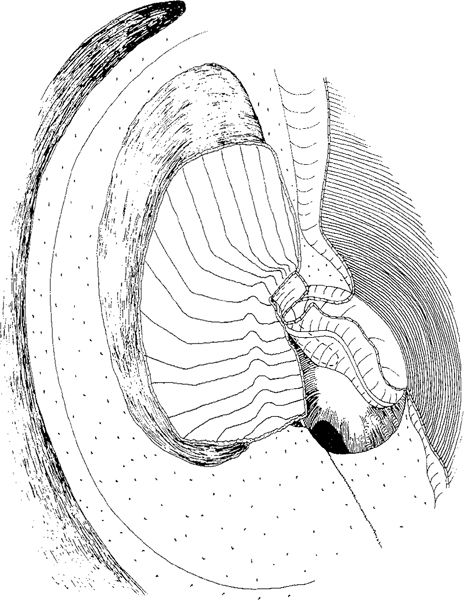
Fig. 438 Covering the atticotomy with fascia. The fascia is stretched over the atticotomy, and has no contact with the underlying ossicles. It is placed over the bridge, but under the drum
Reconstruction of Atticotomy with an Intact Chain
Covering the atticotomy opening in cases with an intact ossicular chain and intact bridge is relatively easy, because retraction does not usually occur in the atticotomy region. Even if retraction does occur, the membrane will attach to the incus body and malleus head, and usually does not extend any further posteriorly. The atticotomy opening can be covered by autogenous fascia grafts (Figs. 438, 439), tragal or conchal cartilage, or a piece of autogenous cortical bone (Fig. 440). Covering the atticotomy opening is really not a problem in cases with an intact, normally positioned bridge. Especially useful in such cases are small pieces of bone acquired by chiseling of the mastoid process, since the shape of these pieces often fits exactly into the atticotomy opening.
When using conchal cartilage, which is slightly concave in shape, a piece can be adapted to the shape of the atticotomy opening and the bridge. First, a piece of silastic can be cut to the appropriate size and shape, and then a piece of cartilage of exactly the same shape as the silastic can be cut and placed onto the attic defect (Fig. 440).
Since covering the attic with bone or cartilage makes it impossible to see into the attic after the operation, the author prefers, particularly in cases with an intact chain and intact bridge, to cover the atticotomy opening with fascia in order to be able to see into the attic and exclude residual cholesteatoma, avoiding the need for a second-look operation.
Care is taken to place the fascia onto the denuded neck of the malleus (Fig. 439a) and anteriorly between the bridge and the drum (Fig. 438). The fascia should not cover the malleus head or the incus body, and there should be some space between the ossicles and the fascia. The small malleus flap and the other ear canal skin flaps are replaced, and the ear canal is packed with Gelfoam balls and small pieces of gauze moistened with oxytetracycline hydrochloride and hydrocortisone ointment (Terra-Cortril). Finally, a thick tube is placed through a separate hole behind the incision and into the cavity for ventilation (Fig. 441).
Generally, there is only a minor risk of retraction in cases with an intact ossicular chain and intact bridge, and if retraction occurs, it starts between the neck of the malleus and the bony bridge, i. e., at exactly the same place as the attic retraction that caused the original attic cholesteatoma (Fig. 442). If the atticotomy opening is only covered with fascia, retraction may occur at the atticotomy, but will adhere to the malleus head (Fig. 442a) and seldom progress. The bridge and part of the medial edge of the ear canal may be resorbed and the retraction may extend with a large and safe neck (Fig. 443a). If the atticotomy opening is covered with bone (Fig. 439b), the retraction may become deep (Fig. 442b), extending behind the reconstructed ear canal wall (Fig. 443b).
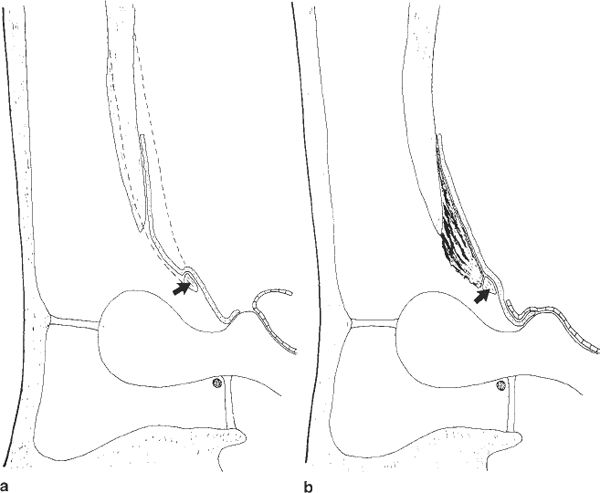
Fig. 439 Side view of the modified intact canal wall mastoidectomy with atticotomy, intact ossiculuar chain, and preserved bony bridge (arrow).
Stay updated, free articles. Join our Telegram channel

Full access? Get Clinical Tree


